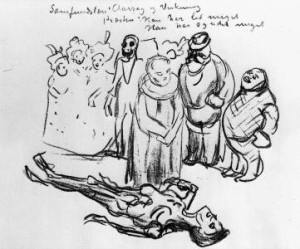‘Beware of the Holy Whore: Edvard Munch and the Dilemma of Emancipation’ is a project organised by the Office for Contemporary Art Norway (OCA) and Fondazione Bevilacqua La Masa in Venice, as the official Norwegian representation at the 55th International Art Exhibition, La Biennale di Venezia in 2013.
The exhibition, which includes a series of rarely exhibited works by Edvard Munch in addition to a newly commissioned film by Lene Berg, revolves around emancipation as an issue always vexed with contradiction – between the realm of freedom and the consequences of the isolation that often accompany the pursue of a qualitatively different, ‘alternative’ life.
The exhibition, curated by Marta Kuzma, Director, OCA, Angela Vettese, President, Fondazione Bevilacqua La Masa and Pablo Lafuente, Associate Curator, OCA, will bring together rarely exhibited works from the collection of the Munch Museum in Oslo with Lene Berg’s new film Ung Løs Gris (Dirty Young Loose, 2013), in order to explore the relationship between art, its social context and changing gender relationships, both in the age of emancipation in which Munch lived and today.
At the beginning of the 20th century, sexual norms and traditional gender roles were questioned amid new psychological theories of sex and politics and a struggle for women’s equality. Challenged by such developments, Munch faced the alienation that characterised the Christiania Bohemia, a society bidding for emancipation but trapped in ‘reality’, struggling between two options: assimilating shared values, or going beyond them in order to construct a new frame for perception. Munch’s emphatic treatment of these themes from 1902 to 1908, before entering the asylum, reflected an internal ambiguity and anguish. Munch described this period as an ‘eternal civil war’, after which his work moved to a more distanced treatment of subjects, in social caricatures in which he offers an ironic critique of an increasingly capitalist and permissive society. In Social Studies: Cause and Effect, made shortly after, Munch also reflected upon the conditions of artistic production and its reception, via patronage, sales, criticism and public opinion, opening new dimensions for his work, from a psychological perspective into social and historical realms.
These issues are echoed in Lene Berg’s Dirty Young Loose, a film that concentrates on three stereotypical characters who are interrogated about their roles as either victims or perpetrators in a complex situation. The film explores the interpretation of human behaviour based on preconceived concepts and established norms. Just like the exhibition as a whole, the film presents the deconstruction of an original scene which functions as a catalyst for a revision of the politics of liberation, of gender struggle and of internal conflict – the dilemma of emancipation.


